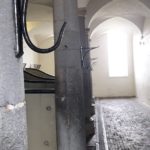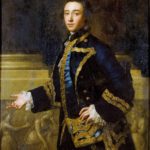Castletown House, built in the early 18th century by William Conolly, is one of Ireland’s largest and finest Palladian houses in Ireland. Now in the hands of the OPW, thousands visit Castletown every year to see this architecture gem and learn about its history. Yet one important aspect of this house’s history remains overlook…. And that is its fine stables!
Castletown House, designed by the Italian Architect Alessandro Galilei, was completed by Edward Lovett Pearce. Pearce also designed a range of stables in the east wing as part of the palladian style layout of the house. In undertaking the project, Pearce introduced a new and grand element to stable architecture! His 7 bay stable pavilion supported by Tuscan columns, Tuscan columns that acted as heel posts for the stalls! Edward Lovett Pearse’s understudy Richard Castles replicated this same design in Carton House, Maynooth Co. Kildare and also in the Ardbracken Stables.
Inside the stable wing there are 2 stable blocks, each containing 5 stalls. These 5 stalls are separated by a parking section for the coaches. In addition, the ground floor section also contains a tack room. The upstairs was remodelled in the 19th century (discussed later) but in the 18th century, the first floor contained the hay loft.
All this expense, of course, suggests that stables were perhaps an important status symbols among the nobility and gentry. Unfortunately, William Conolly did not get to enjoy his fine stables. He died in 1729, the same year the house was completed. Instead, the stables had to wait until 1759, when Thomas Conolly, grandnephew of William, came into his great uncle’s inheritance. Tom may have been responsible for the addition of an apothecarie to the stable block. The apothecarie, situated towards the front of the house on the east wing ground floor, was near Tom’s office. Indeed, Tom had easy access to the stable wing from his office inside the house!
Thomas Conolly (1738-1803) quickly made a reputation for himself as a man interested in horses. In fact, his exploits over in the Curragh Racecourse earned him the title ‘Father of the Turf’. Tom held both Irish and English memberships to the turf clubs which was quite a prestigious and rare honour. Putting his money where his money was, Tom also sponsored many horse races and even presented a gold cup valued at 200 guineas at the Curragh. His reputation was such that a straight on the Curragh Racecourse that was named the ‘Conolly’s Mile’ in his honour.
Unfortunately it is unlikely that his race horses would have been kept at Castletown but his hunt horses and couch horses would have been stabled here! Names for some of Tom’s horse included Whiskey, Hector and Apollo! As you can imagine, hunting was an important past time for the gentry and Tom was no exception. In fact, it could be argued he was one of the leaders in the field! Tom was one of the founding members of the Kildare Hunt and the first hunt master. He certainly seems to have taken pride in that post as records suggest the silver buttons for the master’s jacket were commissioned from goldsmith Jerimiah D’Olier. Today D’Olier Street in Dublin is named after this famous goldsmith.
After Tom’s passing, the stables appear to have remained unaltered until 1871 when the upper story was remodelled. The hayloft disappeared and was replaced by a Billiard Room, Hunting Room and Library!
The importance of the horse tradition continued to evolve right into the 20th century. William Conolly-Carew, 6th Baron Carew and Lady Silvia Maitland their children Diana and Patrick Conolly Carew both excelled in show jumping and events. Representing Ireland for show jumping in Mexico Olympics in 1968. Diana was the first lady rider to be on the successful AGA Khan cup winning team in 1963. Before the House was sold in 1965 there were Horse Trials held here in 1963, 1964 and 1966 and as recently as 1991-1992.
Today in the 21st century the East wing stable block is used for holding events, conferences, recitals and lectures.
As you can see, the HORSE and the STABLE played a vital role in the history of Castletown. In the coming years, we hope to open up the stories surrounding our stable wing. We look forward to future visits and sharing these stories with you!



